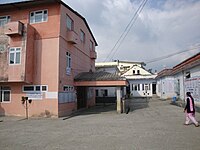Dhankuta: Difference between revisions
Citation bot (talk | contribs) Alter: title. | Use this bot. Report bugs. | Suggested by Abductive | Category:Pages using infobox settlement with possible motto list | via #UCB_Category 1175/1622 |
No edit summary |
||
| Line 71: | Line 71: | ||
| blank1_name = [[List of roads in Nepal|Highway]] |
| blank1_name = [[List of roads in Nepal|Highway]] |
||
| blank1_info = [[Koshi Highway]] |
| blank1_info = [[Koshi Highway]] |
||
| website = {{url|www.dhankutamun.gov.np |
| website = {{url|www.dhankutamun.gov.np}} |
||
| footnotes = |
| footnotes = |
||
| numbers of wards = |
| numbers of wards = |
||
Revision as of 02:16, 23 May 2021
Dhankuta
धनकुटा | |
|---|---|
City | |
 A view of Dhankuta hill town | |
| Nickname: Eastern Hillstation | |
| Motto(s): Hamro Dhankuta, Ramro Dhankuta | |
| Coordinates: 26°59′0″N 87°20′0″E / 26.98333°N 87.33333°E | |
| Country | |
| Province | Province No. 1 |
| District | Dhankuta District |
| Government | |
| • Mayor | Mr. Chintan Tamang (NCP) |
| • Deputy Mayor | Ms. Shakuntala Basnet (NCP) |
| Population (2011[1]) | |
• Total | 26,440 |
| • Ethnicities | Athpahariya Rai Yakha Limbu Brahmin Chhetri Gurung |
| • Religions | Kiratism Hinduism Buddhist |
| Time zone | UTC+5:45 (NST) |
| Postal Code | 56800 |
| Area code | 026 |
| Climate | Cwa |
| Highway | Koshi Highway |
| Website | www |
Dhankuta (Template:Lang-ne )[2] is a hill town and the headquarter of Koshi Zone located in Dhankuta District of Eastern Nepal. According to 2011 Nepal census, it has population of 26,440 inhabitants.
History

Until about 1963 Dhankuta Bazaar (the town) was the administrative headquarters for the whole of north-eastern Nepal. Located a half-mile above the town were the buildings of the Bada Hakim, the feudal district governor of the whole north-eastern region, a man with enormous power. The town also had the regional jail and army post. Because of Dhankuta's isolation from the lowland Terai and from Kathmandu, it was in many ways a self-governing area.[3]
Income to purchase items (cloth, kerosene, batteries, medicines, etc.) that could not be produced locally came from a combination of sales of hill produce (tangerines, potatoes, etc.) and funds repatriated back into the hills by Gorkha soldiers serving first in the British and then more-often in the Indian armies.[3]
The first five (3 male; 2 female) American Peace Corps Volunteers arrived in Dhankuta Bazaar in Fall, 1962 to work as teachers in the two high schools. In October 1963 three male PCV's arrived to help establish the new Panchayat Development program.[3]
From 1963 Nepal was divided into 75 Panchayat Districts, and the traditional Dhankuta administrative region was divided up into about six of the panchayat districts. The power of the Bada Hakim was transferred to the central government's appointed Panchayat Development Officer and each district's elected Panchayat President.[3]
During the pre-panchayat period Dhankuta Bazaar prided itself as being in the cultural vanguard, a relatively progressive community with its own "intellectual" elite. Dhankuta Bazaar, already in the 1930s, had the only high school in Nepal to be located outside of the Kathmandu Valley. Early on it added a girl's high school and a two-year college.[4]
Then and now there is a sharp contrast between Dhankuta Bazaar and the surrounding rural villages. The town is a commercial center and has a population that is primarily Newar. The surrounding area is agricultural and the population is made up of many caste/tribal groups, notably Aathpaharia, Limbu, Yakkha, Rai, Magar, Tamang and Tibetan.
Present status


Dhankuta Bazaar, on the North-South Koshi Highway, is now the administrative headquarters for the Eastern Development Region, and is home to a number of offices for NGOs and aid agencies serving in the area. The large bazaar of Hile further up the road, is an important trading centre and major road head, serving the remote hinterlands of the Arun valley and Bhojpur. Villagers walk for many days from surrounding districts to trade in Hile and Dhankuta bazaars, although road building in the district may reduce the importance of these centers.
‘Nepal's cleanest city’ as proposed by The Kathmandu post.[5]
Vegetation
The vegetation zones in the district range from sub-tropical Sal forest along the Tamur and Arun rivers, and cooler temperate forests on some of the high ridges that mark the watershed between the two catchments. The altitude ranges from around 300m to 2500m. The majority of the population are involved in agriculture and crops include maize, rice and millet. Important cash crops include citrus fruits, cauliflower, cabbage, ginger, and in recent years, tea. A well-preserved forest (Rani Bhan – Queen's Forest) spreads along a ridge line on the northwest side of the village, with well-developed mature stands of rhododendron and pine trees.
Health centres

Dhankuta District Hospital is located off the main street at the south end of the town. The hospital has facilities like inpatient service, Ultrasonography and x-ray. Besides the government posted doctors, medical and dental intern doctors from BPKIHS are also posted there.
Media
Radio Nepal has a regional station in Dhankuta which transmits various programs of mass interest. Likewise, Radio Lali Guransa (105.2 MHz), Radio Makalu Dhankuta (92.2 MHz), and Radio Dhankuta (106.2 MHz) are community radio stations, which transmit local programmes.
References
- ^ "National Population and Housing Census 2011(National Report)" (PDF). Central Bureau of Statistics. Government of Nepal. November 2012. Archived from the original (PDF) on 18 April 2013. Retrieved 1 November 2012.
- ^ "धनकुटा जि.स.स". ddcdhankuta.gov.np.
- ^ a b c d Personal experience of Professor Dick Mayer, Nepal 2 Peace Corps Volunteer, 1963–65
- ^ Professor Dick Mayer, Nepal 2 Peace Corps Volunteer, 1963–65
- ^ "'Nepal's cleanest city'". Retrieved 20 November 2017.



